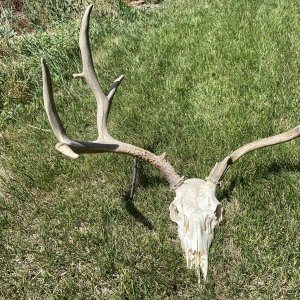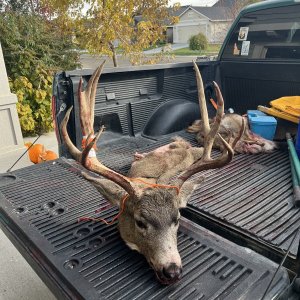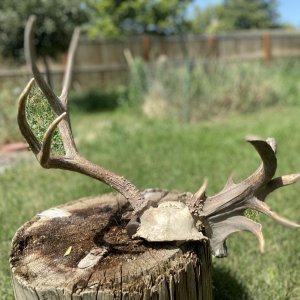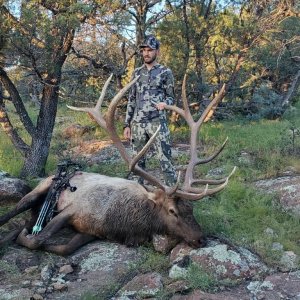You are using an out of date browser. It may not display this or other websites correctly.
You should upgrade or use an alternative browser.
You should upgrade or use an alternative browser.
propane question
- Thread starter eelgrass
- Start date
It is due to the the loss of pressure in the tank causing the frost. Also you can buy a hose that goes from the 20 pound tanks to anything those one pounders fit on. That is what we do now with our stove and other gear in camp...
Mntman
"Hunting is where you prove yourself"
Let me guess, you drive a 1 ton with oak trees for smoke stacks, 12" lift kit and 40" tires to pull a single place lawn mower trailer? See Zeke for prime example....
Mntman
"Hunting is where you prove yourself"
Let me guess, you drive a 1 ton with oak trees for smoke stacks, 12" lift kit and 40" tires to pull a single place lawn mower trailer? See Zeke for prime example....
Roy
Moderator
- Messages
- 7,447
>Just as a tip do you
>know you can refill those
>off of a 5 Gallon
>tank with an adapter you
>can buy at most sporting
>goods stores saving yourself some
>big bucks over the years?
>And the frost only happens
>to me when its cold
>outside.
That's probably only because you only use it when it is cold. As Hank Hill explained above, it is due to the difference in pressure between the atmospheric pressure and the pressure of the bottle.
As the bottle is filled, it is pressurized to a level that is close to atmospheric pressure. As it empties, the pressure of the bottle is much less than the atmospheric pressure and subsequently the temperature inside the bottle drops and in most cases, water in the atmosphere condenses on the bottle and freezes creating frost.
HOOK 'EM!
_______________________________________
Since I am frequently asked about my religion on this site and others, I have created a profile that explains my beliefs. If you are interested in finding out more about my faith, please visit the link below:
http://mormon.org/me/6RNQ/
>know you can refill those
>off of a 5 Gallon
>tank with an adapter you
>can buy at most sporting
>goods stores saving yourself some
>big bucks over the years?
>And the frost only happens
>to me when its cold
>outside.
That's probably only because you only use it when it is cold. As Hank Hill explained above, it is due to the difference in pressure between the atmospheric pressure and the pressure of the bottle.
As the bottle is filled, it is pressurized to a level that is close to atmospheric pressure. As it empties, the pressure of the bottle is much less than the atmospheric pressure and subsequently the temperature inside the bottle drops and in most cases, water in the atmosphere condenses on the bottle and freezes creating frost.
HOOK 'EM!
_______________________________________
Since I am frequently asked about my religion on this site and others, I have created a profile that explains my beliefs. If you are interested in finding out more about my faith, please visit the link below:
http://mormon.org/me/6RNQ/
elkassassin
Long Time Member
- Messages
- 38,477
Just for You Eel!
Wisz was a Hell of a Sport this year even if He did tell the UDWR to F-Off during the Phone Call!
15" Bases?
30" 5ths?
Missing 450" Bull!
The next 4 years is Slicks Fault,again,GEEZUS!
GOOD GAWD A MIGHTY!
Wisz was a Hell of a Sport this year even if He did tell the UDWR to F-Off during the Phone Call!
15" Bases?
30" 5ths?
Missing 450" Bull!
The next 4 years is Slicks Fault,again,GEEZUS!
GOOD GAWD A MIGHTY!
just_a_hunter
Active Member
- Messages
- 484
LAST EDITED ON Nov-27-12 AT 06:32AM (MST)[p]I work in a cryogenic natural gas processing plant with two fractionator trains that separate the different carbons from the gas stream. In other words, I make propane.
When gas comes out of the ground it is raw natural gas and will have a composition of several different carbon elements. Methane, ethane, propane, butanes and gasolines or (Carbon6 pluses.)
In order to separate the differnt elements, the heaviest carbons in the gas stream will need to be turnined into a liquid form in order to separate the lightest element.
In order to get the gas stream into a liquid form, the cas needs to be cooled off with the use of several different refrigeration processes. Propane refrige systems are a common process used in cryogenic gas plants. The essentially work just like a car air conditioner but instead of freeon being used as the refrige these big systems use propane. As propane turns from a liquid to a vapor (flashing off), a chemical reaction at the mixed phase point causes severe temperature drops.
Propane has exellent refrige properties. If propane sits in a propane bottle the pressure of the bottle will be the vapor pressure of the propane thats in the bottle. Consumer spec propane actually has 5% ethane in it. Since propane is heavier then ethane, the more ethane in the propane the higher the vapor pressure the bottle will have. The hotter the ambient temperature is the more the lighter carbons inside the bottle will be in vapor form creating more vapor pressure and visa-versa if its cold. Sometime when it is -20 degrees, the propane will not have enough pressure to leave the bottle if there isn't enough ethane in the product.
As you use propane out of a bottle, the vapor pressure of the bottle is being reduced causing the propane to flash back to the vapor pressure of the product and cooling the metal at the mixed phase point inside the bottle. Where the metal is the coldest, the ambient dew point (the point at which the moisture in the air will turn to a solid) will condence on the bottle and since water freezes at 32 degrees it causes the dew to freeze. As the amount of propane in the bottle reduces, the more the propane has to flash to get to the vapor pressure of the product and since the ethane is lighter, all the ethane will have been used before all the propane. Thats why the frost usually accures when the bottle level is low.
If it is foggy outside its because the dew point is the same temperature as the ambient temperature. Ice storms accure when the ambient dew point is say 40 degrees but the actuall ambient temperature is below the freeze point for water.
This is the short condenced version of my answer. Please keep in mind I am not a scholor which is why I am a operator for a living.
Good hunting,
Todd
When gas comes out of the ground it is raw natural gas and will have a composition of several different carbon elements. Methane, ethane, propane, butanes and gasolines or (Carbon6 pluses.)
In order to separate the differnt elements, the heaviest carbons in the gas stream will need to be turnined into a liquid form in order to separate the lightest element.
In order to get the gas stream into a liquid form, the cas needs to be cooled off with the use of several different refrigeration processes. Propane refrige systems are a common process used in cryogenic gas plants. The essentially work just like a car air conditioner but instead of freeon being used as the refrige these big systems use propane. As propane turns from a liquid to a vapor (flashing off), a chemical reaction at the mixed phase point causes severe temperature drops.
Propane has exellent refrige properties. If propane sits in a propane bottle the pressure of the bottle will be the vapor pressure of the propane thats in the bottle. Consumer spec propane actually has 5% ethane in it. Since propane is heavier then ethane, the more ethane in the propane the higher the vapor pressure the bottle will have. The hotter the ambient temperature is the more the lighter carbons inside the bottle will be in vapor form creating more vapor pressure and visa-versa if its cold. Sometime when it is -20 degrees, the propane will not have enough pressure to leave the bottle if there isn't enough ethane in the product.
As you use propane out of a bottle, the vapor pressure of the bottle is being reduced causing the propane to flash back to the vapor pressure of the product and cooling the metal at the mixed phase point inside the bottle. Where the metal is the coldest, the ambient dew point (the point at which the moisture in the air will turn to a solid) will condence on the bottle and since water freezes at 32 degrees it causes the dew to freeze. As the amount of propane in the bottle reduces, the more the propane has to flash to get to the vapor pressure of the product and since the ethane is lighter, all the ethane will have been used before all the propane. Thats why the frost usually accures when the bottle level is low.
If it is foggy outside its because the dew point is the same temperature as the ambient temperature. Ice storms accure when the ambient dew point is say 40 degrees but the actuall ambient temperature is below the freeze point for water.
This is the short condenced version of my answer. Please keep in mind I am not a scholor which is why I am a operator for a living.
Good hunting,
Todd
B
BIGFOOT46
Guest
Roy said "As it empties, the pressure of the bottle is much less than the atmospheric pressure"
So if the pressure of the bottle is much less than the atmospheric pressure, please explain how the propane comes out of the open valve rather than the atmosphere going into the tank. What you just described is what is referred to in the scientific community as a vacuum in a bottle.
So if the pressure of the bottle is much less than the atmospheric pressure, please explain how the propane comes out of the open valve rather than the atmosphere going into the tank. What you just described is what is referred to in the scientific community as a vacuum in a bottle.
just_a_hunter
Active Member
- Messages
- 484
Atmospheric pressure is 0 PSI... Vapor pressure of propane is with 5% ethane is 100ish psi at 60 degrees ambient temp.. It varies quite a bit depending on temp.
Todd
Todd
Roy
Moderator
- Messages
- 7,447
>Roy said "As it empties, the
>pressure of the bottle is
>much less than the atmospheric
>pressure"
>
>So if the pressure of the
>bottle is much less than
>the atmospheric pressure, please explain
>how the propane comes out
>of the open valve rather
>than the atmosphere going into
>the tank. What you
>just described is what is
>referred to in the scientific
>community as a vacuum in
>a bottle.
"Propane has exellent refrige properties. If propane sits in a propane bottle the pressure of the bottle will be the vapor pressure of the propane thats in the bottle. Consumer spec propane actually has 5% ethane in it. Since propane is heavier then ethane, the more ethane in the propane the higher the vapor pressure the bottle will have. The hotter the ambient temperature is the more the lighter carbons inside the bottle will be in vapor form creating more vapor pressure and visa-versa if its cold. Sometime when it is -20 degrees, the propane will not have enough pressure to leave the bottle if there isn't enough ethane in the product.
As you use propane out of a bottle, the vapor pressure of the bottle is being reduced causing the propane to flash back to the vapor pressure of the product and cooling the metal at the mixed phase point inside the bottle. Where the metal is the coldest, the ambient dew point (the point at which the moisture in the air will turn to a solid) will condence on the bottle and since water freezes at 32 degrees it causes the dew to freeze. As the amount of propane in the bottle reduces, the more the propane has to flash to get to the vapor pressure of the product and since the ethane is lighter, all the ethane will have been used before all the propane. Thats why the frost usually accures when the bottle level is low."
This.
I just explained it in a far less complex way. Sorry if I over-simplified it, but the same principle applies. Only at extreme temperatures and atmospheric conditions would you get the "vacuum in a bottle" effect you are describing.
Oh, and I wouldn't be going around bragging that you are a member of "the scientific community" if I were you Bigfoot46, at least not around actual members of "the scientific community".
HOOK 'EM!
_______________________________________
Since I am frequently asked about my religion on this site and others, I have created a profile that explains my beliefs. If you are interested in finding out more about my faith, please visit the link below:
http://mormon.org/me/6RNQ/
>pressure of the bottle is
>much less than the atmospheric
>pressure"
>
>So if the pressure of the
>bottle is much less than
>the atmospheric pressure, please explain
>how the propane comes out
>of the open valve rather
>than the atmosphere going into
>the tank. What you
>just described is what is
>referred to in the scientific
>community as a vacuum in
>a bottle.
"Propane has exellent refrige properties. If propane sits in a propane bottle the pressure of the bottle will be the vapor pressure of the propane thats in the bottle. Consumer spec propane actually has 5% ethane in it. Since propane is heavier then ethane, the more ethane in the propane the higher the vapor pressure the bottle will have. The hotter the ambient temperature is the more the lighter carbons inside the bottle will be in vapor form creating more vapor pressure and visa-versa if its cold. Sometime when it is -20 degrees, the propane will not have enough pressure to leave the bottle if there isn't enough ethane in the product.
As you use propane out of a bottle, the vapor pressure of the bottle is being reduced causing the propane to flash back to the vapor pressure of the product and cooling the metal at the mixed phase point inside the bottle. Where the metal is the coldest, the ambient dew point (the point at which the moisture in the air will turn to a solid) will condence on the bottle and since water freezes at 32 degrees it causes the dew to freeze. As the amount of propane in the bottle reduces, the more the propane has to flash to get to the vapor pressure of the product and since the ethane is lighter, all the ethane will have been used before all the propane. Thats why the frost usually accures when the bottle level is low."
This.
I just explained it in a far less complex way. Sorry if I over-simplified it, but the same principle applies. Only at extreme temperatures and atmospheric conditions would you get the "vacuum in a bottle" effect you are describing.
Oh, and I wouldn't be going around bragging that you are a member of "the scientific community" if I were you Bigfoot46, at least not around actual members of "the scientific community".
HOOK 'EM!
_______________________________________
Since I am frequently asked about my religion on this site and others, I have created a profile that explains my beliefs. If you are interested in finding out more about my faith, please visit the link below:
http://mormon.org/me/6RNQ/
1911
Long Time Member
- Messages
- 6,197
LAST EDITED ON Nov-27-12 AT 08:30AM (MST)[p]Isn't the whole thing caused from the rapid evaporation (a reaction which takes heat) as the liquid turns to gas in the tank. Same principle as a air conditioner/heat pump. Just so happens that propane has superb refrigerant properties. Get a can of compressed air and dump the whole can non stop and the same thing happens. Can gets cold. The reason for the line at the level of propane is is simply because the evaporation reaction draws the heat from the liquid to the vapors. Same principle as putting a wet rag on a forehead for a fever. The water evaporates, the reaction takes heat, the heat is drawn from the liquid water and taken off with the water vapor thus the wet rag feels cold. Put the rag in front of a fan, expedite the evaporation and the cooling process is magnified. As propane evaporates it is a rapid process, much more so than water into the air, which makes it an ideal refrigerant minus the whole flammable qualities it also carries.


just_a_hunter
Active Member
- Messages
- 484
LAST EDITED ON Nov-27-12 AT 08:56AM (MST)[p]LAST EDITED ON Nov-27-12 AT 08:51?AM (MST)
1911,
I would say you are right on the money about evaporation and the cooling properties associated.
However, the cooling properties as in a refrige system is not an evaporation process even though it is very very similar. Instead of using temperature to get the desired effect, the process uses a pressure drop and cooling happens on two fronts. The Jewell Thomos effect or "J.T." creates a lot of cooling at the spec break.
If you take a deep breath and blow into the palm of your hand with your lips puckered, then the pressure drop at your lips will cool the air considerably and you can feel it against your hand. That is the J.T. effect and slightly different then an evaporation process but to be honest, we are splitting fine hairs as it all takes energy transfer to happen.
We all could go on for days about it but Roy summed it up pretty well but his pressure terms through me for a loop as well. Honest mistake. It was obviouse to me he is not ignorant.
Todd
1911,
I would say you are right on the money about evaporation and the cooling properties associated.
However, the cooling properties as in a refrige system is not an evaporation process even though it is very very similar. Instead of using temperature to get the desired effect, the process uses a pressure drop and cooling happens on two fronts. The Jewell Thomos effect or "J.T." creates a lot of cooling at the spec break.
If you take a deep breath and blow into the palm of your hand with your lips puckered, then the pressure drop at your lips will cool the air considerably and you can feel it against your hand. That is the J.T. effect and slightly different then an evaporation process but to be honest, we are splitting fine hairs as it all takes energy transfer to happen.
We all could go on for days about it but Roy summed it up pretty well but his pressure terms through me for a loop as well. Honest mistake. It was obviouse to me he is not ignorant.
Todd
1911
Long Time Member
- Messages
- 6,197
Overton just called me with a question. He is in the field nancing around in camo undies somewhere near Wells Nevada so I will post it for him.
If this whole pressure thing results in cold air when going from high to low pressure rapidly, he wants to know why his farts are hot?
He's an idiot but I thought I'd amuse his request.

If this whole pressure thing results in cold air when going from high to low pressure rapidly, he wants to know why his farts are hot?
He's an idiot but I thought I'd amuse his request.

There is reason to get upset about it. Just think of it as a custom fuel gage, that tells you when you are getting close to running out.
I don't have one of those adapters to fill a one pounder, but I do have a hose and it really comes in handy. I got it at a yardsale.
John 14:6
I don't have one of those adapters to fill a one pounder, but I do have a hose and it really comes in handy. I got it at a yardsale.
John 14:6
Eel what are you doing messing around with propane?? Isn't coal more your era??? A lifesaver in the woods or desert is a propane hose hooked up to an air chuck. If you have a slow leak the 250# of air pressure is sure nice to have. I learned this from the old ranchers I know. The only problem is you need to bleed it off before you get to the tire shop or they will freak out and you don't want to leave the propane in a tire for a long period of time because the gas will eat the inside of the tire. Be careful, but it has got me out of some jams moving farm equipment around in the past!














